Leaderboard
Popular Content
Showing content with the highest reputation on 12/06/2024 in all areas
-
Sorry to correct the "jumping carp": It's a KOINOBORI, a windsack in form of a carp used as an auspicious symbol on boy's day on May 5th. An UKIYO-E by Hiroshige (maybe the model for the TSUBA in question?): Best, Florian5 points
-
Good Lord, what a train wreck. I have seen SO many fine WWII rifles RUINED with sandpaper and cold bluing paste... I see this field is equally susceptible to this. My uncle used to say, "The surface of the Earth is covered in a roughly even layer of morons". I think he was correct.4 points
-
Hello friends, I want to show you the construction I have made of a new Kake. All this is born from the needs that I did not find in the market, because I have been looking for a long time for a Kake in robust acrylic. The first phase was the design, I took a classic Kake as a starting point, generating a traditional design with reliable measurements. To do the first tests, I chose to work with a laminated wood of the same dimensions, the thickness of this design is 10 mm. After doing the first tests, which were simply about reproducing the dimensions that I would later work with acrylic, I thought about varnishing to give a more premium finish and try to emulate the Kakes that have carved or lacquered family emblems and tsubas. So here I bring you the first tests to see what you think. In the next few days, if this post is of interest, I will upload the Kakes in acrylic, these can also be worked in the same way. I understand that it is not the typical traditional work, but it seems like a good option as well as being totally customizable, both in types of engraving, carving and colors. I'm leaving you with some photos so you can give me your own impressions, as well as if you have any ideas on how I can improve.3 points
-
Bob thanks for asking check the website below for details. there is a link for room reservations. It is April 25-27, 2025 http://www.chicagoswordshow.com/ Let me know if you have any questions tahnks mark jones3 points
-
I have seen the words 板鍔 (I assume meaning a plain plate) and 錬皮鍔 used for older periods. The leather one is usually soaked, hammered, dried, and lacquered, and then reinforced with a metal rim and large seppa (or so I understand). Mr. Ogawasara in his book 鍔 wrote that the simple and naive designs on tosho/kachushi tsuba are an evolution of the plain plate tsuba worn by lower ranking warriors (Mr. Katsuya calls it the development of "folk art"). And there was also some development from the richly decorated tachi tsuba worn by more wealthy warriors as they started to wear uchigatana.3 points
-
3 points
-
Concerning the timeline I waited for this Tsuba with controversial dating to pop up but now I yield it by myself: It is owned by the Museum of Fine Art in Boston and according to Okabe Kakuya who wrote the first museum catalog in 1908 it is a Momoyama piece. Okabe interpreted the combination of gourd and kiri as a hint to Toyotomi Hideyoshi and the background pattern of snowflakes is said to have been a popular fabric design at this time, too. I think even today the museum refers to this dating (see also „Lethal Elegance“ by Joe Earle). The very same Tsuba is depicted in Sasano’s TOSOGU NO KIGEN (1979). He focused on the peculiar form of the hitsu-ana. In the named book he sums up the development of Kogai and Kozuka pointing out that the early ones have a flat design while later with the Goto-lineage more and more relief-like decoration appeared. This makes it necessary to change the form of the hitsu-ana to larger, rounded ones. In correspondence with other examples showing similar primary hitsu-ana he dates it back to the Nambokucho period. About 200 years difference! There are others who dated it in between those periods and I don’t think there will be ever an ultimate answer. But why I mentioned this Tsuba is that the age estimation is based on one hand on the design, on the other hand on a technical background. Best, Florian3 points
-
2 points
-
I think the emergence of ko-tosho and ko-katchushi tsuba out of a plain-plate foundation can certainly be seen to have occurred as early as the 15th century. It isn't much of a stretch to imagine a smith deciding to perforate a simple motif into a plain plate, or even for the owner of a sword himself to do so (perhaps quite crudely). Once others saw the motif of a crescent moon, or snowflakes, or a butterfly, it is fairly easy to see how it could catch on and become "trendy." And once the concept took hold, it could kind of explode into more ambitious ko-sukashi expressions, such as that seen in Florian's example above (which I think is clearly Muromachi). But I think Glen's (OP's) thread here was begun with the focus on ji-sukashi tsuba in mind, especially. And perhaps even more so, those that are not the "usual" kuruma-sukashi or kiku-sukashi designs, i.e., those produced out of the traditions now called Kyo-sukashi, Owari sukashi, and Kanayama. Such ji-sukashi designs, I believe, did not come into existence until -- at the earliest -- the very end of the Muromachi Period, and perhaps more likely, the early Momoyama Period. One consideration as regards how early the kuruma-sukashi designs may have emerged: the earliest tsubako who regularly signed their works were Nobuiye, Yamasaka Kichibei, and Kawaguchi Hoan, all of whom lived and worked in the castle town of Kiyosu, Owari, at least for a time, in the 1570s - 1580s (and maybe as early as the 1560s). Each of them made kuruma-sukashi tsuba, and two of them -- Yamasaka Kichibei and Kawaguchi Hoan -- made them as a relatively large proportion of their output. The question here is whether these smiths more or less "invented" or reinvigorated the design themselves, or if they instead were simply following trends in that direction that had already been established by others. There is no evidence that I am aware of that the kuruma-sukashi design was already present and popular at the time of the emergence of these three smiths (instead, I believe plain-plate tsuba, as well as some ko-tosho and ko-katchushi guards were prevalent). Moreover, according traditional Japanese practices, artisans of a kind, such as potters and lacquerware craftsmen, often/usually lived in the same parts of town, even on the same street, and so it is quite possible that Nobuiye, Yamasaka Kichibei, and Kawaguchi Hoan were neighbors who saw one another's works and perhaps even had some conversations about it. Even if this were the case, though, there is something of a conceptual jump from the regular patterns we seen in kuruma-sukashi (and kiku-sukashi) sword guards to the more sophisticated expression seen in ji-sukashi designs representing a variety of motifs, as in Kyo-sukashi, Owari-sukashi, and Kanayama works. Perhaps these can be seen as something of a marriage between the motif expression found in ko-tosho/ko-katchushi -- which presented definite subjects, such as dragonflies -- and the more openwork kuruma-sukashi designs of the Kiyosu masters. The presence of European swords in Japan by the mid-16th century, too, may have exerted considerable influence toward the development of the much more open ji-sukashi designs. All of this suggests a dynamic time in the expressive potential of sword guards in the latest Muromachi and early Momoyama years. Add in the factor of the advent of some tsuba being regularly signed meant that tsubako had gained enough cultural gravitas to put significantly more consideration and effort into the refining of their works than may have usually been the case in the relatively simplistic ko-tosho and ko-katshushi forms.2 points
-
About the place of production, I think they have always been produced in Nanman until the end of war, or to be more exact, produced in the city of Dalian(大連). I have found a document, it is a section from the memoirs of ex-SMR staff. I made an interpretation below. It says, in July 1944, 三笠宮殿下(a royal member, the little brother of Japanese emperor)visited the Mantetsu gunto manufactory, 松岡洋右(the boss of SMR)planned to present a Koa isshin gunto as a gift. Therefore, the factory began to produce Koa Isshin gunto from 18th July 1944, they finally made 6 swords, and one of them was piked out as a gift. So at least they were still making Mantetsu gunto in Dalian in July 1944. the stamp 'Nan' (南,means south),the stamp 'Ren'(連,possibly stands for the city name Dalian or DaiRen,大連,where they were forged). The photo below is the Mantetsu gunto manufactory(滿鐵大連鍛刀所)in shahekou district of Dalian. I hope these would help. Zi2 points
-
Hello there, Im just speaking from my own experience, because I have a sword with an “ugly” habaki. I am currently having a new habaki made, with shirasaya for this sword. I was told the habaki was hideous (and I agree). Unlike your hypothetical question though, I plan to have this sword polished. I hope to keep the old habaki on the tsunagi with koshirae. That being said, I think the answer to your question lies in the sword itself. If the sword is very nice, it’s only natural that you’d want it to have a nice habaki. For the more experienced, has anyone seen a juyo blade with a plain copper habaki? If so, is that common? Just curious. Cheers and may the force be with you, -Sam2 points
-
Easily double or triple your money in parts. OR have your smitty weld on New nakago2 points
-
It is really fun trying to dig info on old koshirae as I have wonderful references in general (even though they are really focused on swords). I was looking into Fukushi Shigeos Tōsōgu Classroom and I am bit puzzled about what I read but it seems there are several theories on many Muromachi fitting making schools as there is just so little historical information and old theories are gradually being improved. Here is a Nanbokuchō period tachi koshirae of Kasuga Taisha that is designated as Jūyō Bunkazai. Photo credits go to Sankei Shimbun (I just saved the picture): https://www.sankei.c...H35JUHNNY7ZFUJGZTBA/ I am hoping to visit Kasuga Taisha in 2025 as I have not yet been there. Nor do I have a book focused on solely on their sword collection. Unfortunately in my references I only have a tiny side view on this koshirae. Here is also a link to the famous Uesugi Tachi that currently resides in Tokyo National Museum. I believe it it thought that both blade and koshirae are made at the same time during Kamakura period. While the tsuba is a single plate the ō-seppa on this have openings in the bird carvings. https://www.gov-onli...24/june_2024-12.html I think there would be one interesting followup question. If the sukashi tsuba timeline is pushed back to the end of Muromachi period, what kind of tsuba was used in 1400's and 1500's?2 points
-
I have a problem with the idea that the first to develop a design or style is automatically the "Best" - Why wouldn't subsequent artists improve on the workmanship? After all they have a baseline on which to improve.2 points
-
2 points
-
2 points
-
Pay the hundred bucks, throw away the metal stick and make double your money on the tassel, guard, hilt and scabbard. 🤣2 points
-
Bruce: As a holster, belt, and wallet maker, I would carefully cut the stitching along the side then remove it. The saya cover can then be re-stitched using a blind stitch or a saddle stitch if you want it to stick out. I mention this method because the other method would be to wet the leather to soften it then work it off. Much more difficult and could cause shrinking and cracking once dry again. You could also try a leather conditioner to see if it becomes pliable enough, but I don't think it would. Not many options to do it safely. There may be some saddle makers in your area that could do it. John C.2 points
-
2 points
-
Thank you Brian! About a year ago, I decided to organize the information I had collected about Ayanokoji Nagamine, an obscure craftsman who remains somewhat enigmatic to me. What started as a simple task of adding a few pages to my collection catalog gradually evolved into a more significant effort of compiling all the referenced pieces and information I had gathered from various sources. This project was primarily a way to make sense of the material I had found through different resources, including online auction sites. As I worked on it, I began noticing patterns and similarities that sparked my curiosity and led me to pursue further research. Initially, I intended to keep the results to myself, thinking they might be flawed, and that it's better to stay silent than risk being wrong and looking foolish. However, I then thought about sharing this work in the tosogu section of the NMB to encourage discussion among members. Perhaps some of the more knowledgeable individuals in the community might provide valuable insights or additional information to expand or correct the work. Even if it turns out that my conclusions are inaccurate, I will have gained new knowledge, even at the risk of making mistakes publicly. I would deeply appreciate your feedback on this work. If you have any additional information, corrections, suggestions for improvement, or images of reference pieces not included in the PDF that you are willing to share, it would mean a lot to me. Thank you in advance for your time and contributions. Best regards, Luca2 points
-
I started off writing about the "schools issue" but then it was really hard to separate it from the "NBTHK papers" issue since they are the major perpetuators of these school constructs... So here's a little starter to think about: The MAJORITY of the supposed "schools" of sukashi tsuba makers have NO period documentation to prove their exact timing or duration of production, nor their area of production. Kanayama, Owari, Heianjo-sukashi/kyo-sukashi, and especially the "ko-shoami" (one of the most laughable attempts to "create a school" I have seen yet). These were all 20th century CONSTRUCTS that were created on suppositions and inferences starting with Akiyama, and were perpetuated and "refined" by many of the tsuba collectors and authors he influenced, like one of his later students Torigoye. Sasano also adhered to these categorizations and published his works in English, which then set the “doctrine” in stone for most of the English speaking collectors around the world. Most people would assume that Japan’s NBTHK is the foremost authority on the identification and classification of tsuba, and often defer to their perceived authority as though they have access to secret tomes and manuscripts that they must be referring to in order to make their judgements. Unfortunately this is not the case and they clearly don’t even take the time to look into their own past attributions because they frequently contradict themselves or offer up different assessments for the same tsuba that has been submitted on more than one occasion. They probably take more time to write the paper itself than they do to assess the tsuba in front of them. It’s just a “cash cow” for them… easy money. Unfortunately the NBTHK is predominantly (maybe even exclusively?) populated by people who have adopted these Akiyama-type school names and labels. Keep in mind they are a private organization, who get paid to "certify" that a sword or sword fitting was genuinely produced by a specific maker, or by one of the "schools". So, it is safe to assume that they will inherently act in their own self interest to perpetuate the system they have created. As a result, they have either knowingly or unknowingly magnified the problem of attributions for unsigned tsuba, because there are a limited number of groups to choose from in the Akiyama framework, so they have frequently “expanded” the original grouping to include a variety of “outlier tsuba” with significantly different characteristics, but somehow similar enough that they thought they could all be "acceptably" grouped together under the same banner. Somewhere along the way, people within this organization decided that was the right way to go… which makes sense, because I could see that if they didn’t do that, people would stop paying money to an organization that frequently gave back papers saying “unknown maker or school of production, but here’s a pretty paper that says so…” Unfortunately, there is no visible attempt by this group to do any further study based on detailed comparison. And thanks to the internet, the accumulation of contradictory examples of their attributions is continually building and revealing the serious flaws and contradictions within this paid, for-profit system. Under a better system, these groupings should be split up into separate groups of makers (based on the shared common characteristics in the manner of the tsuba’s production), and each group given its own name or title rather than being lumped together under the same artificial banner for the sake of simplicity and maintaining the established system. Something like Haynes’ systematic numbering of known tsuba smiths who signed their work. For example, I bet we could start parsing out all the examples of “Kanayama” and “den Kanayama” by looking at details such as the tegane (punch marks) around the nakago-ana, the seppa-dai dimensions and proportions, the manner in which the corners and edges of the sukashi are done, the position of “iron bones” along the face of the mimi (rim of the- tsuba) etc… I'm certain we could even start grouping them by individual smiths within the larger group. Ideally, a non-invasive technique should be used to identify the percentage composition of the elements found in the steel, so we can more easily group tsuba together by location of their source of sand iron that was used to make the steel (even if we probably couldn’t know where that specific sand iron came from within Japan…).1 point
-
Hello, and good day, I just found a WWII sword in a local small town gun shop, it was brought in by a WWII Marine veteran's family, and essentially "given" to the shop owner, as they had no interest and the veteran had passed away. I got it for a reasonable (to me) trade. I am very new to this field. The amount of variation is dizzying, and I speak nor read any Japanese. Im guessing it is a WWII production blade. It is extremely sharp, but the blade has several small chips to the Ha, and some mild corrosion. The hamon looks irregular and "dainty", for lack of a better descriptive term. It is difficult to photograph. All parts are serialled "74", and all match each other. Beyond that, I will let the photos speak for themselves. I am extremely excited to find this, and intend to start a modest collection of Nihonto, but have a LOT to learn. I previously was a longtime (somewhat published) collector and researcher of WWII German firearms....that was easy compared to this! Any help would be greatly appreciated. Thank you, and I am looking forward to my new hobby growing and learning is my passion. Jeff1 point
-
This would be Yamagata Prefecture prior to the serial number prefix of MA マ. 昭和十七年五月日 A day in May 1942. ☆ 羽州山形住昭吉作 74 "Star" Ushū Yamagata-jū Akiyoshi saku 74.1 point
-
Hi, Bruce, Yes, The SMR buildings in Dalian are now being used as museum ,exhibition gallery and liberary. However, it is a pity that exhibitions are mainly about history of SMR, not quite relate to its edged weapon manufacture. I am glad to post the details of my sword. It was forged in Autumn 1942(昭和壬午年秋), the number is Ku 101 (ク101). Zi1 point
-
If I'm not mistaken this was previously from the Donald Barnes collection and was part of the large auction here in Australia a couple of years ago. It is the same sword featured in the larger Fuller & Gregory book (Pages 124 & 125).1 point
-
1 point
-
Thanks Arnaud! I do believe these tsuba types were quite common for old battlefield ōdachi and tachi as there are several surviving koshirae from Nanbokuchō and early Muromachi period that feature these at various shrines in Japan. I think I am just bit puzzled about the developments in tsuba as there seems to be few conflicting theories. And there can be lots of difference in dating for some tsuba as has been already evidenced in this thread.1 point
-
1 point
-
Strange tsuba. The brass side looks like it could be a shiremono pressing affixed over an iron plate? I even wonder if the iron plate is cast with mixed metal onlay. Shoki’s face looks shibuichi or maybe shakudo and the Oni is also mixed/patinated soft metal. Might look/feel totally different “in hand” but its definitely “unusual”1 point
-
Yet another question as I look over every minute detail of this sword. I cannot figure out the saya coating paint, or lacquer, or how this interesting, uniform texture was achieved. It looks more like a molded thin layer was applied...of, "something". Thin leather of a ray or other animal? Also, pic under magnification of the hamon edge, because I did not know my camera could do that.1 point
-
Only just noticed that Kuniyoshi's depiction of Hazama Kihei Mitsunobu (Yama Kihei Mistunobu) has what looks very much like an Ainu Pattern Cowl. Kuniyoshi was known for his eclectic interests including Western Perspective, Dutch Old Masters and Cats Any Thoughts on this?1 point
-
You won't be able to remove it without damaging or destroying the leather unfortunately. This style of leather was shrink fitted while wet, unfortunately in their wisdom they did not imagine collectors having to deal with the consequences of this technique 80 years later. Best to care for the leather as best you can.1 point
-
Ha! Hi Jeff! Boy, you jumped into the pool at the deep end, for sure! Love it! So, starting at the beginning, read: Legally Rebutting the "Type 3" Sword Name - Nick Komiya Unveiling the Rinji seishiki Sword, 1940 - Nick Komiya Arsenal Marks on RJT Swords Ray, Is this Sasakawa or Fujita? I'm really bad at this, but it looks like Fujita to me - {出羽山形住藤田昭吉), Sesko's list1 point
-
Jeff: Type 3 is sometimes referred to as type 100 and refers to the style of mounts. See Ray's link for details. The star stamp identifies the sword as a "gendaito", meaning a traditionally made blade as opposed to a mass-produced or machine made blade. So yes, a more desirable blade. It looks as if the blade has some condition issues, however still a nice piece of history and a good find. John C.1 point
-
1 point
-
Hello Tensho Thanks for showing this dress sword, here is another example of this model. From time to time, similar pieces from the early days of the Japanese armed forces appear on the market. I consider these two pieces to be regular IJA models from the 1870s. Wherever a Japanese officer carries a dress sword, there is also a kyu gunto. If one has survived and is now in a collection, I would be very happy to see it here! Michael1 point
-
1 point
-
Nakago is horribly done, and it's gimei. But it's genuine antique if that's what you want to know. Tamahagane means nothing in this case, since just about all antiques would be considered as such, even when mixed with other steels. Registration card is a license, so adds nothing. If you like the blade, then enjoy it. But don't add anything to your value of it from the torokusho or mei.1 point
-
1 point
-
I want to clarify my objection concerning the demand for historical illustrations. Edo-period illustrations (excluding pattern books of course) depict hardly any individual Tsuba-Design although we know many different models were in use. But this obviously means nothing. llustrations from Muromachi-times depict also no individual Tsuba-Design - but this shall proof their non-existence. I can only speculate why Tsuba patterns have been omitted by the artists through the times, but at least the illustrations cannot (or only in some cases) consulted to back up the development of Tsuba. Florian1 point
-
Thank you for the clarification. My take would be: 1. There are transitional tsuba types having Kofun qualities but dating to Muromachi - I attached one example. They are rare, but their existence convinces me the "sukashi" pattern lived on, and even though continental-tachi type tsuba were popular, it was also a more "official" and "high class" type, while others were more associated with "ordinary work". Quite a few known examples are not in Japanese books because unfortunately Japanese society is centered around dealers, and dealers have little interest in archeology - therefore everything knowledge-wise is skewed towards what can be traded and not towards proof-of-concept singular pieces with verifiable date or history. I can upload photographs of what I believe to be Nanbokucho/early Muromachi sukashi, but all are highly symmetric "ray-like" designs. Can I prove the date? Is an interesting and long question, certainly pre-late-Muromachi there is always a conjecture at some point and some manner of unreliable interpretation, but on the other hand they do form for me a straight line all the way to Kofun (?). 2. There is an interesting disconnect between what was exported/left in 16th century Korea versus what is available today in Japanese market as late Muromachi works; Indeed nothing complicated can be found in overseas gifts or finds with verifiable dates. Lots of sukashi with central symmetry. However, its also possible that early ko-sukashi was limited to high grade items, in which case quality can become a distinguishing factor.1 point
-
Don't go for these either! https://www.jauce.com/auction/t1128823426 https://www.ebay.com/itm/275533181538 https://www.ebay.com/itm/283780856270 Carter's Price Guide to Antiques and Collectables. This would not strike me as a worthy piece to be included in such a guide! These are nice though! https://www.tessier-...fer-a-decor?search=& https://www.tessier-...-1945-mokko?search=&1 point
-
1 point
-
1 point
-
Humans like to put things in neat little boxes, collectors like to know what they have and covet things that are rare, important and/or have artistic merit. The NBTHK provide a service to help categorise and sort objects, there is a general consensus that they are in the best position to provide this service, there are clear rules and most collectors accept the categories and rankings. It is a game that most people accept and play, many collectors have a vested interest in the system and maintaining favourable attributions and I do not think there will be any significant shifts in the near future. That said there is vast gulf of information about Tosogu that is just not known and may never be known without new research and evidence surfacing, particularly for items pre-dating the Edo period. I agree that the categories used are often quite lose, sometimes totally illogical and are not adequately supported by sufficient evidence. I think the primary issue is that most people take the attributions at face value, without much thought, not realising that many of the categories are nothing more than groupings and educated estimates.1 point
-
Beside the fact that these school names didn't even exist before the 1920s, here’s a prime example of how some/most of these pre-Edo school are merely constructs of convenience: **NOTE: Unfortunately I received this info from a long time collector of 30 years, so I don’t have a precise reference or quote to give you at the moment. If anyone can find it, it would be much appreciated. The collector thinks it may have been in some of the publications from the meetings that occurred in the early days with Akiyama and the group of collectors he would meet with. I do not have these documents so I can not verify his statement. Apparently there is a publication that sates that Akiyama saw that the 3rd generation Yamakichibei (the only one who signed with a location and a sakura flower) was from the Owari area in the early Edo period (mid to late 1600s), so he presumed that all unsigned sukashi tsuba from the Azuchi-Momoyama period 100 years earlier must also be from the Owari area (eg. All the Owari and Kanayama tsuba which had some similar aesthetic sensibilities, as well as all the signed Yamakichibei tsuba). So technically, we don’t even know for certain that the Owari and Kanayama tsuba were even produced in the Owari area… we just all presume this to be true and throw it around like a fact. In addition to that, we can’t say for sure that there was a single “school” that was producing these “Owari sukashi tsuba” or how many smiths were involved, or when their production of these tsuba started and ended.1 point
-
Not sure a sword owned by a daimyo is a typical example to use for the average sword price for your average samurai... This is clearly an excessive amount for most members of the samurai class.1 point
-
I think in the period specified most transactions would already be taking place with set currency at that point in the history. Kokudaka would probably only be used for larger scale transactions or transactions in the agricultural sector such as village taxes or fund allocations for a wider fief or samurai house by 1750 or later. Your typical ronin or low ranking samurai was being paid in rice but not making payments in kokudaka save for currency exchange. According to Sesko, 1 Ryo was valued at about 4,000 mon and the average samurai retainer was therefore earning around 12,000 mon a year or 1,000 mon per month. Sesko gives a range of prices for complete swords but the average appears to be between 21,000 and 30,000 mon, so between 1 year and 9 months and 2.5 years salary for a lower ranking retainer. Of course, higher quality work would cost even more than this, as much as 45,000 mon or 3 years 9 months salary according to Sesko. Good luck changing these figures into USD or modern day currencies lol. In any event, the question that remains is how much was a tsuba worth relative to the rest of the sword?1 point
-
Here the second sword I wanted to share with the same lighting, that was a cloudy day but rays of sunlight sometimes enlighted the steel. This is a Koto - Tokebutsu Hozon - Sekishu Sadatsuna, pupil of oif Naotsuna witch could have been one of the ten brilliant disciples of Masamune (but there is a debate on his name). Not to confound with the other Sadatsuna from the Ko-Hoki school (Heian era). Here is a Nanbokusho swordsmith with a strong Soshu influence. By the way Sekishu was not far from Bizen and had very qualitative black sand to make steel. here the link to the commercial site https://eirakudo.shop/607544 for professional pictures and diverse information. This sword appealed me by this all along sunagashi that run like a waterfall from the top to the bottom of the sword : I call this whirl the "eye of Fudo Miio" : And this Kaen Boshi complete the flame theme of Fudo Miio And the tsuba is depicting a Fudo Miio under a waterfall, mirroring the sword.1 point
-
Grey and i picked up a tsuba. We are having trouble understanding the inscription. We see left --- Masa Toshi Saku Kore so we think Masatoshi made this but i guess maybe it could be read differently like Sho??? right side -- we are lost, maybe O (Nori Toku), Aki , Hiro, Tsune ???? probably completely wrong Also we note the Hozon paper uses a different kanji for Toshi, so we are not sure if the paper uses an abbreviated form of the kanji on the tsuba or maybe the NBTHK knows who this is and the maker used this other kanji as well ?? any help appreciated, thanks Mark and Grey1 point
This leaderboard is set to Johannesburg/GMT+02:00

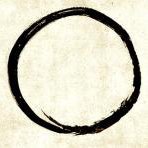

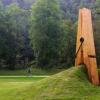


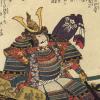


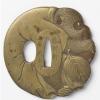
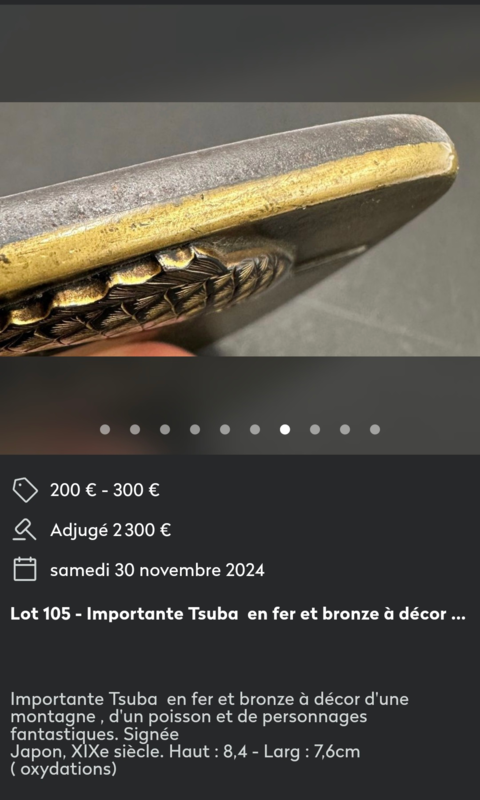
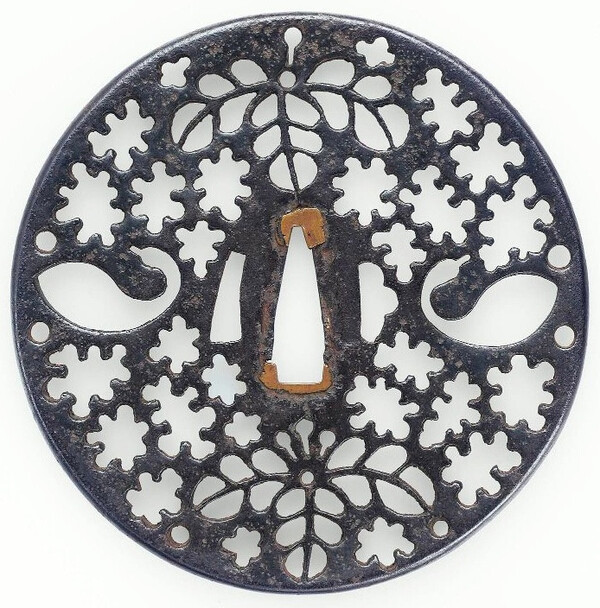

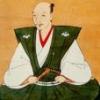






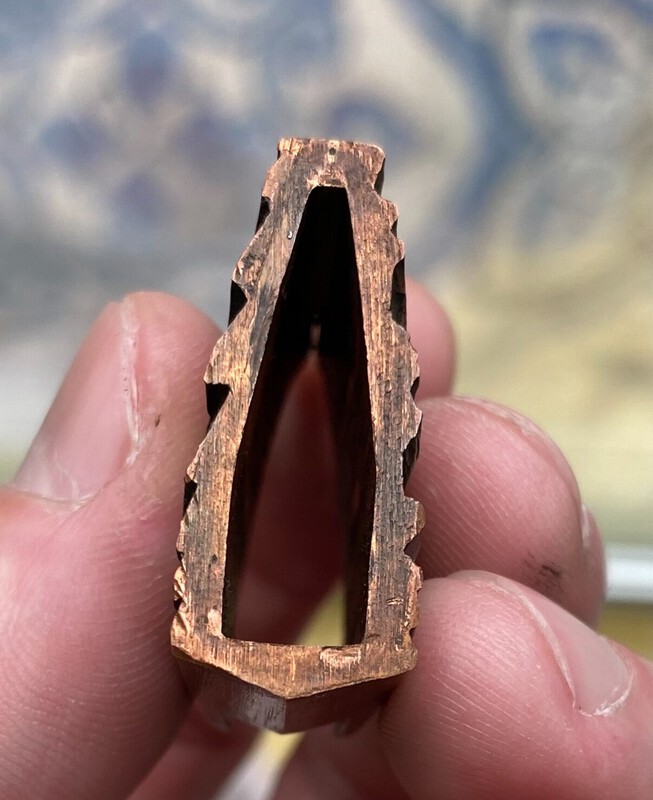


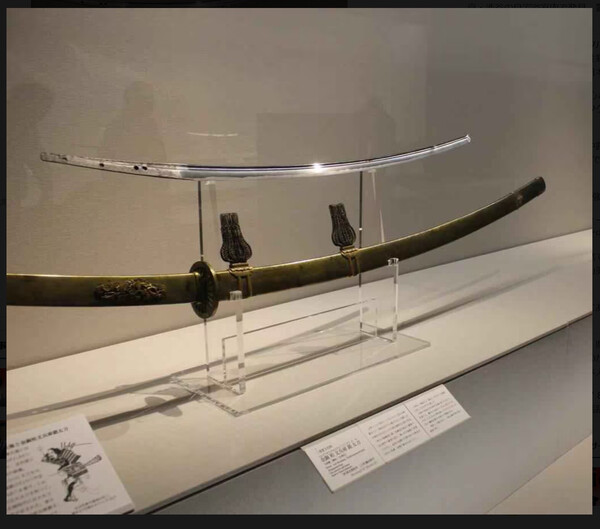


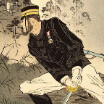


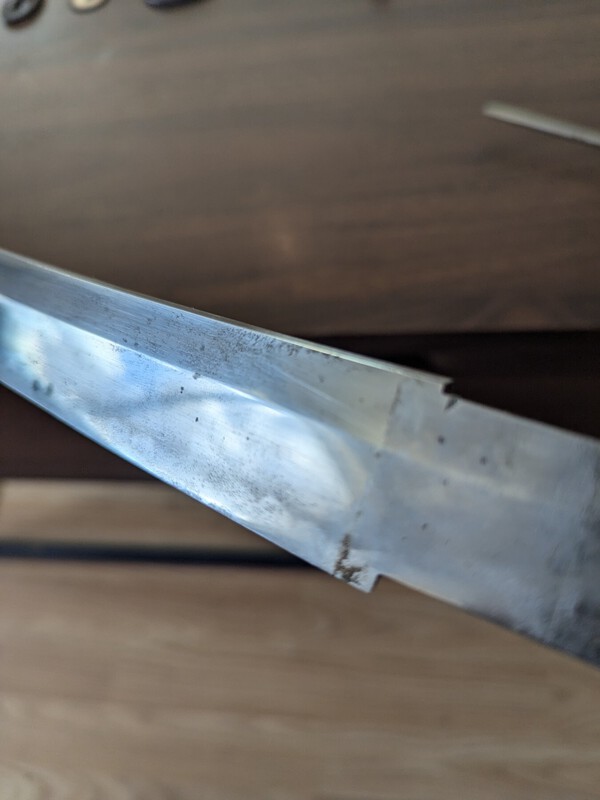






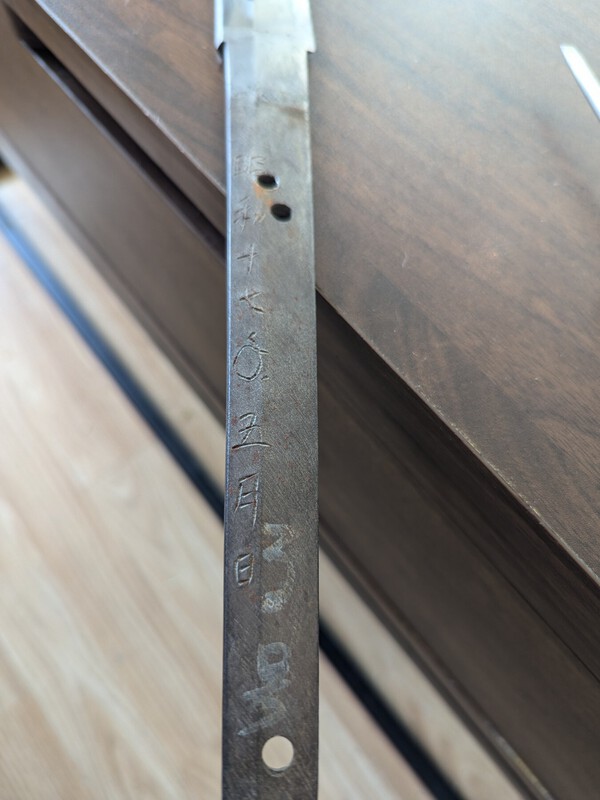

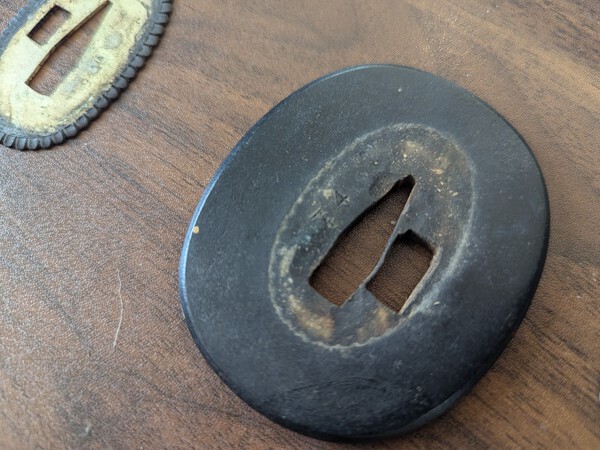
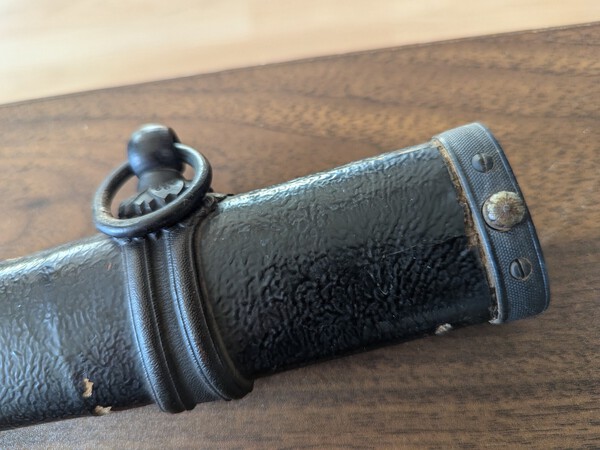









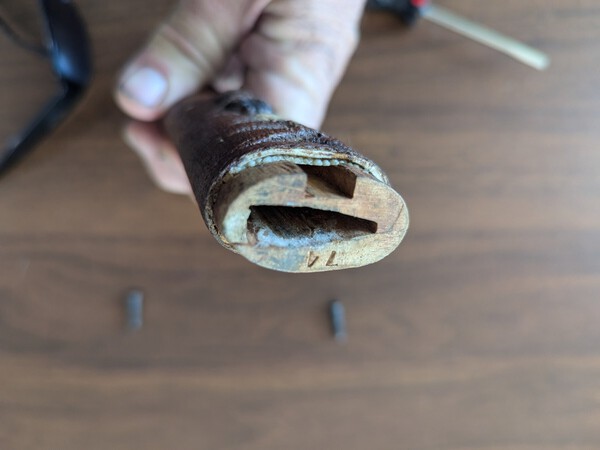





















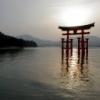

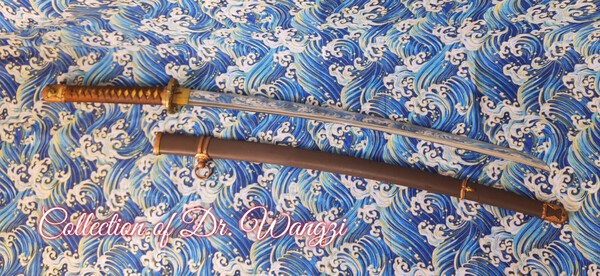
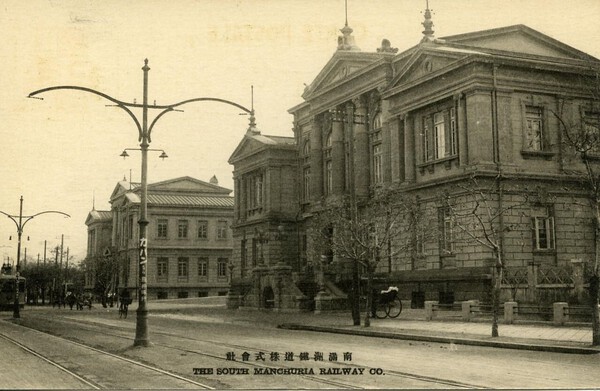





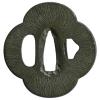
.thumb.png.4c5df79fec171b2dc4a23af38e280a4d.png)










